2018 MERCEDES-BENZ SLC ROADSTER ECU
[x] Cancel search: ECUPage 49 of 298

GWARNING
If the PASSENGER AIR BAG OFF indicator
lamp is lit, the front-passenge rfront air bag is
disabled. It wil lnot be deploye dinthe event of
an accident and cannot perform its intended
protective function. Apersonint he front-
passenger seat coul dthen, for example, come
into contact with the vehicle's interior, espe-
cially if the personiss itting too close to the
dashboard. This posesani ncreased risk of
injury or even fatal injury.
When the front-passenge rseat is occupied,
alway sensure that:
Rthe classification of the personint he front-
passenger seat is correct and the front-
passenger front air bag is enabled or disa-
bledina ccordance with the personint he
front-passenge rseat
Rthe front-passenge rseat has been moved
back as far back as possible.
Rthe personiss eated correctly.
Make sure ,both before and during the jour-
ney, that the status of the front-passenger
front air bag is correct.
GWARNING
If you secure achild in arearward-facing child
restraint system on the front-passenge rseat
and the PASSENGER AIR BAG OFF indicator
lamp is off, the front-passenge rfront air bag
can deploy in the event of an accident. The
child coul dbestruck by the air bag .This poses
an increased risk of injury or even fatal injury.
Make sure that the front-passenge rfront air
bag has been deactivated. The PASSENGER
AIR BAG OFF indicator lamp must be lit.
NEVER use arearward-facing child restraint
on aseat protected by an ACTIVE FRONT AIR-
BAG in front of it; DEATH or SERIOUS INJURY
to the child can occur.
If the PASSENGER AIR BAG OFF indicator lamp
stays off, do not instal larearward-facing child
restraint system on the front-passenge rseat.
You can find more information on OCS under
"Problems with the Occupant Classification Sys-
tem" (
Ypage4 9).
GWARNING
If you secure achild in aforward-facing child
restraint system on the front-passenge rseat
and you position the front-passenge rseat too
close to the dashboard, in the event of an
accident, the child could:
Rcome into contact with the vehicle's inte-
rior if the PASSENGER AIR BAG OFF indi-
cator lamp is lit, for example
Rbe struck by the air bag if the PASSENGER
AIR BAG OFF indicator lamp is off
This poses an increased risk of injury or even fatal injury.
Move the front-passenge rseat as far back as
possible.A lways make sure that the shoulder
belts trap is correctly routed from the vehicle
beltg uide to the shoulderb eltguide on the
child restraint system. The shoulderb eltstrap
must be routed forwards and downwards
from the vehicleb eltguide. Always observe
the child restraint system manufacturer's
installation instructions.
If OCS determines that:
RThe front-passenge rseat is unoccupied,t he
PASSENGER AIR BAG OFF indicator lamp
lights up after the system self-test and
remains lit. This indicates that the front-
passenger front air bag is deactivated.
RThe front-passenge rseat is occupied by a
child of up to twelve months old, in astandard
child restraint system, the PASSENGER AIR
BAG OFF indicator lamp lights up after the
system self-test and remains lit. This indi-
cates that the front-passenge rfront air bag is
deactivated.
But even in the case of atwelve-month-old
child ,inas tandard child restraint system, the
PASSENGER AIR BAG OFF indicator lamp can
go out after the system self-test. This indi-
cates that the front-passenge rfront air bag is
activated. The result of the classification is
dependent on, among other factors, the child
restraint system and the child's stature. Make
sure that the conditions for acorrect classi-
ficatio nare met. If the PASSENGER AIR BAG
OFF indicator lamp remains off, do not install
ac hild restraint system on the front-
pa
ssenger seat.
Occupant safety47
Safety
Z
Page 55 of 298
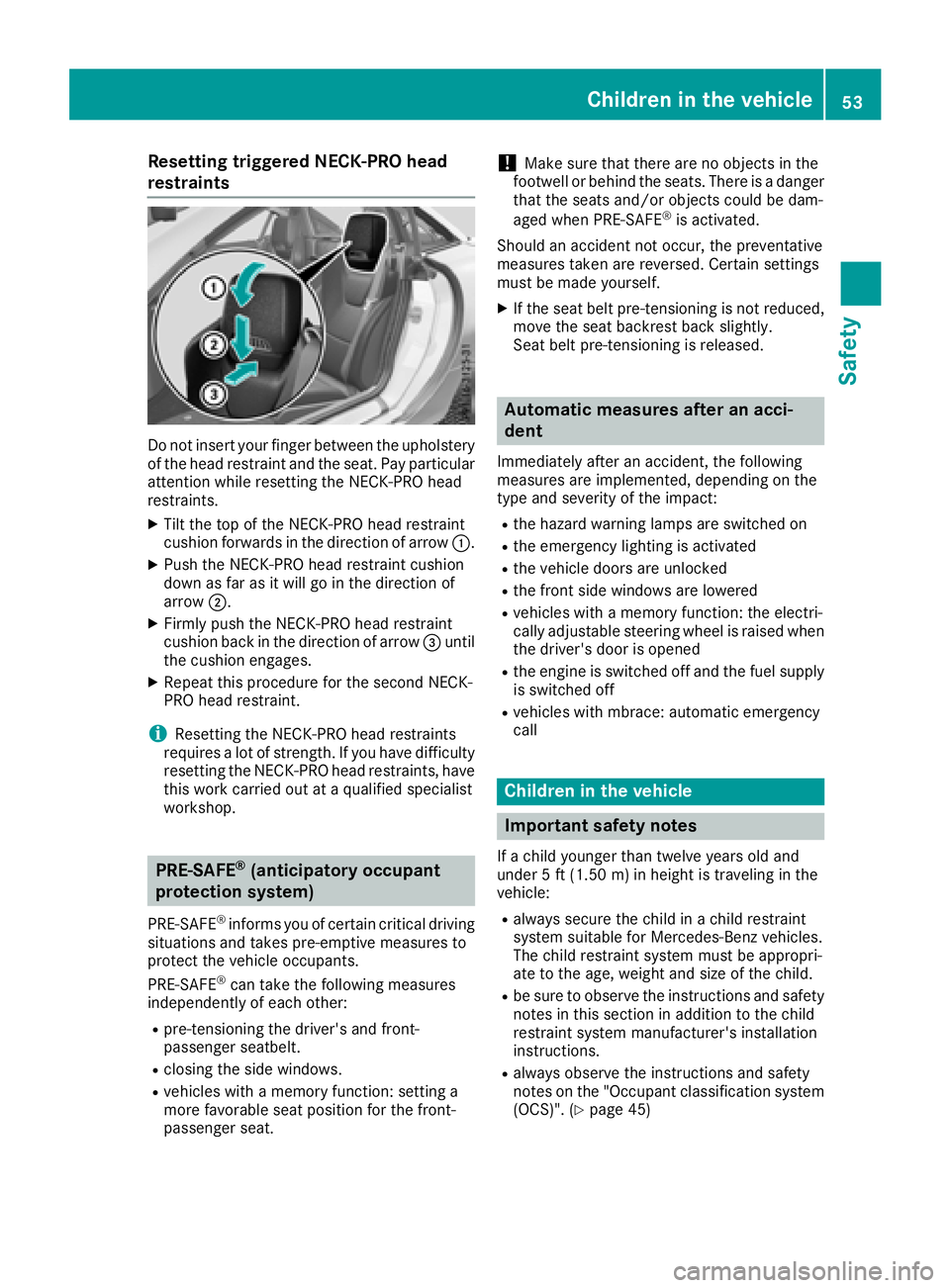
Resetting triggeredNECK-PRO head
restraints
Do not insert your finger between the upholstery of the headr estraint and the seat. Payp articular
attention whil eresetting the NECK-PROh ead
restraints.
XTilt the top of the NECK-PROh eadrestraint
cushio nforward sinthe direction of arrow :.
XPush the NECK-PROh eadrestraint cushion
dow nasfar as it will go in the direction of
arrow ;.
XFirmly push the NECK-PROh eadrestraint
cushio nbackint he direction of arrow =until
the cushio nengages.
XRepea tthis procedure for the second NECK-
PROh eadrestraint.
iResetting the NECK-PROh eadrestraints
requires alot of strength. If yo uhaved ifficulty
resetting the NECK-PROh eadrestraints, have
this work carrie doutataq uali fied specialist
workshop.
PRE-SAFE®(anticipatory occupant
protection system)
PRE-SAFE®informs yo uofcertain critical driving
situations and take spre-emptive measures to
protect the vehicl eoccupants.
PRE-SAFE
®can take the following measures
independentl yofeacho ther:
Rpre-tensioning the driver'sa nd front-
passenger seatbelt.
Rclosing the sid ewindows.
Rvehicles with amemory function: setting a
more favorabl eseatp osition for the front-
passenger seat.
!Make sure that there are no objects in the
footwell or behind the seats. There is adanger
that the seats and/or objects could be dam-
aged when PRE-SAFE
®is activated.
Should an accident not occur, the preventative
measures take nare reversed. Certai nsettings
mus tbem adey ourself.
XIf the seatb eltp re-tensioning is not reduced,
move the seatb ackrest back slightly.
Seatb eltp re-tensioning is released.
Automatic measures after an acci-
dent
Immediately afte ranaccident, the following
measures are implemented, depending on the
typ eand severity of the impact:
Rthe hazard warning lamps are switched on
Rthe emergency lighting is activated
Rthe vehicl edoors are unlocked
Rthe front sid ewindow sare lowered
Rvehicles with amemory function: the electri-
cally adjustabl esteering wheel is raised when
the driver'sd ooriso pened
Rthe engine is switched off and the fue lsuppl y
is switched off
Rvehicles with mbrace: automatic emergency
call
Childrenint he vehicle
Important safety notes
Ifac hild younger than twelve years olda nd
under 5ft(1.50 m) in height is traveling in the
vehicle:
Ralways secur ethe child in achild restraint
systems uitabl efor Mercedes-Benz vehicles.
The child restraint systemm ustbea ppropri-
ate to the age, weight and size of the child.
Rbe sure to observe the instructions and safety
notesint hissectio nina dditiontot he child
restraint systemm anufacturer's installation
instructions.
Ralways observe the instructions and safety
notesont he "Occupant classification system
(OCS)". (
Ypage 45)
Children in the vehicle53
Safety
Z
Page 56 of 298
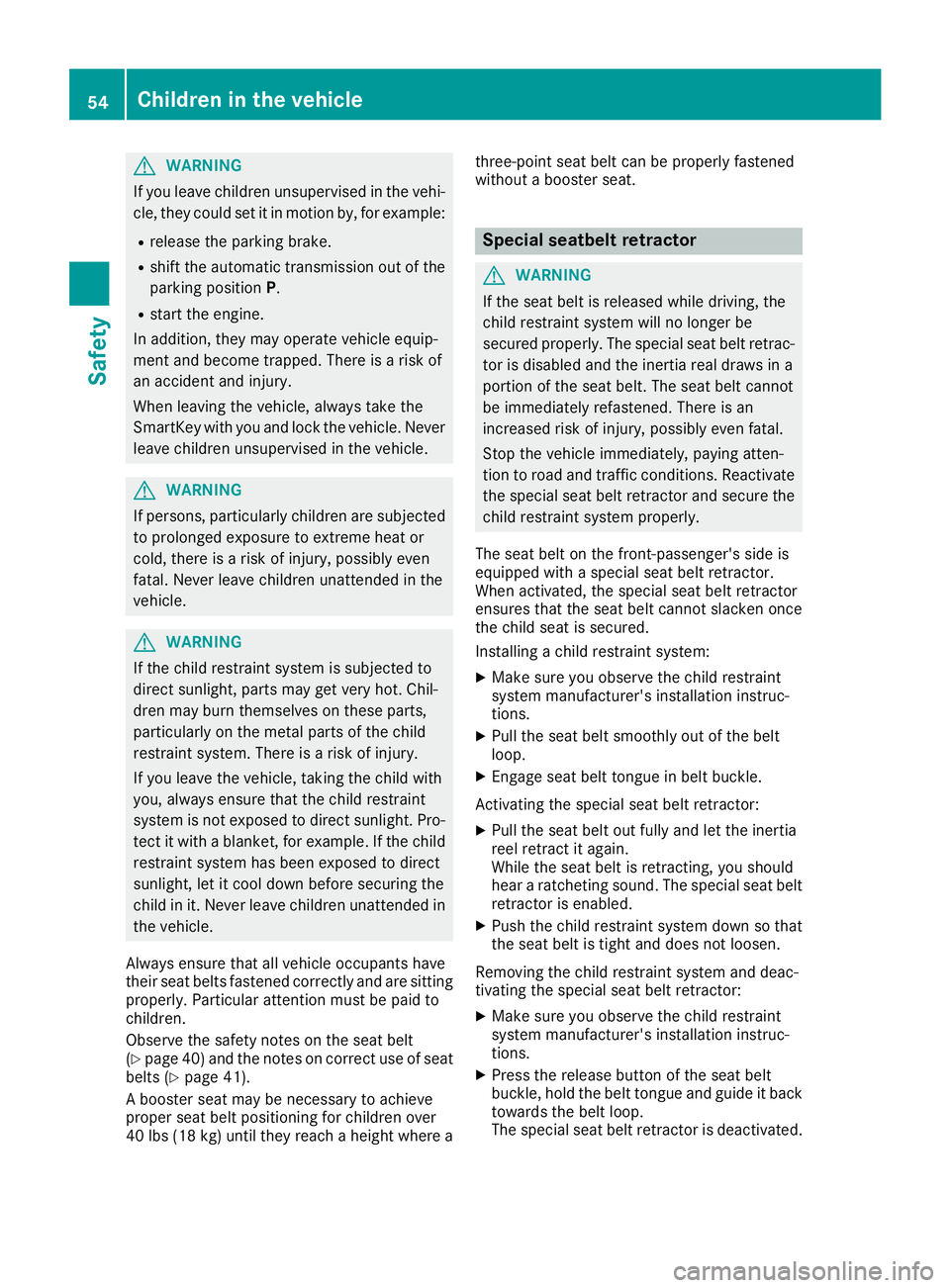
GWARNING
If you leave children unsupervised in the vehi-
cle, they coul dset it in motion by, for example:
Rrelease the parking brake.
Rshift the automatic transmission out of the
parking position P.
Rstart the engine.
In addition, they may operate vehiclee quip-
ment and become trapped. There is arisk of
an accident and injury.
When leaving the vehicle, alway stake the
SmartKey with you and lock the vehicle. Never
leave children unsupervised in the vehicle.
GWARNING
If persons, particularl ychildren are subjected
to prolonged exposure to extreme heato r
cold, there is arisk of injury ,possibly even
fatal .Never leave children unattended in the
vehicle.
GWARNING
If the child restraint system is subjected to
direct sunlight, parts may get very hot. Chil-
dren may burn themselves on these parts,
particularl yonthe metal parts of the child
restraint system. There is arisk of injury.
If you leave the vehicle, taking the child with
you ,alway sensure that the child restraint
system is not exposedtod irect sunlight. Pro-
tect it with ablanket, for example. If the child
restraint system has been exposedtod irect
sunlight, let it cool downb efore securing the
child in it. Never leave children unattended in
the vehicle.
Always ensure that all vehicleo ccupants have
their seat belts fastened correctly and are sitting
properly.P articular attention must be paidt o
children.
Observe the safety notes on the seat belt
(
Ypage4 0) and the notes on correct use of seat
belts (Ypage4 1).
Ab ooster seat may be necessary to achieve
propers eat beltp ositioning for children over
40 lbs (18 kg )until they reach aheight where a three-point seat beltc
an be properly fastened
without abooster seat.
Special seatbelt retractor
GWARNING
If the seat beltisr eleased while driving, the
child restraint system wil lnolonger be
secure dproperly.T he special seat beltr etrac-
tor is disableda nd the inertia real draw sina
portion of the seat belt. The seat beltc annot
be immediatel yrefastened. There is an
increased risk of injury,p ossibly even fatal.
Stop the vehiclei mmediately, paying atten-
tion to road and traffic conditions. Reactivate
the special seat beltr etractor and secure the
child restraint system properly.
The seat beltont he front-passenger's side is
equipped with aspecial seat beltr etractor.
When activated, the special seat beltr etractor
ensure sthat the seat beltc annot slacken once
the child seat is secured.
Installing achild restraint system:
XMake sure you observe the child restraint
system manufacturer's installation instruc-
tions.
XPul lthe seat belts moothly out of the belt
loop.
XEngage seat beltt ongue in beltbuckle.
Activating the special seat beltr etractor:
XPullthe seat belto ut fullyand let the inertia
reel retract it again.
Whilet he seat beltisr etracting, you should
hear aratcheting sound .The special seat belt
retractor is enabled.
XPush the child restraint system downsot hat
the seat beltist ight and does not loosen.
Removing the child restraint system and deac-
tivating the special seat beltr etractor:
XMake sure you observe the child restraint
system manufacturer's installation instruc-
tions.
XPress the release button of the seat belt
buckle,hold the beltt ongue and guide it back
toward sthe beltl oop.
The special seat beltr etractor is deactivated.
54Children in the vehicle
Safety
Page 57 of 298
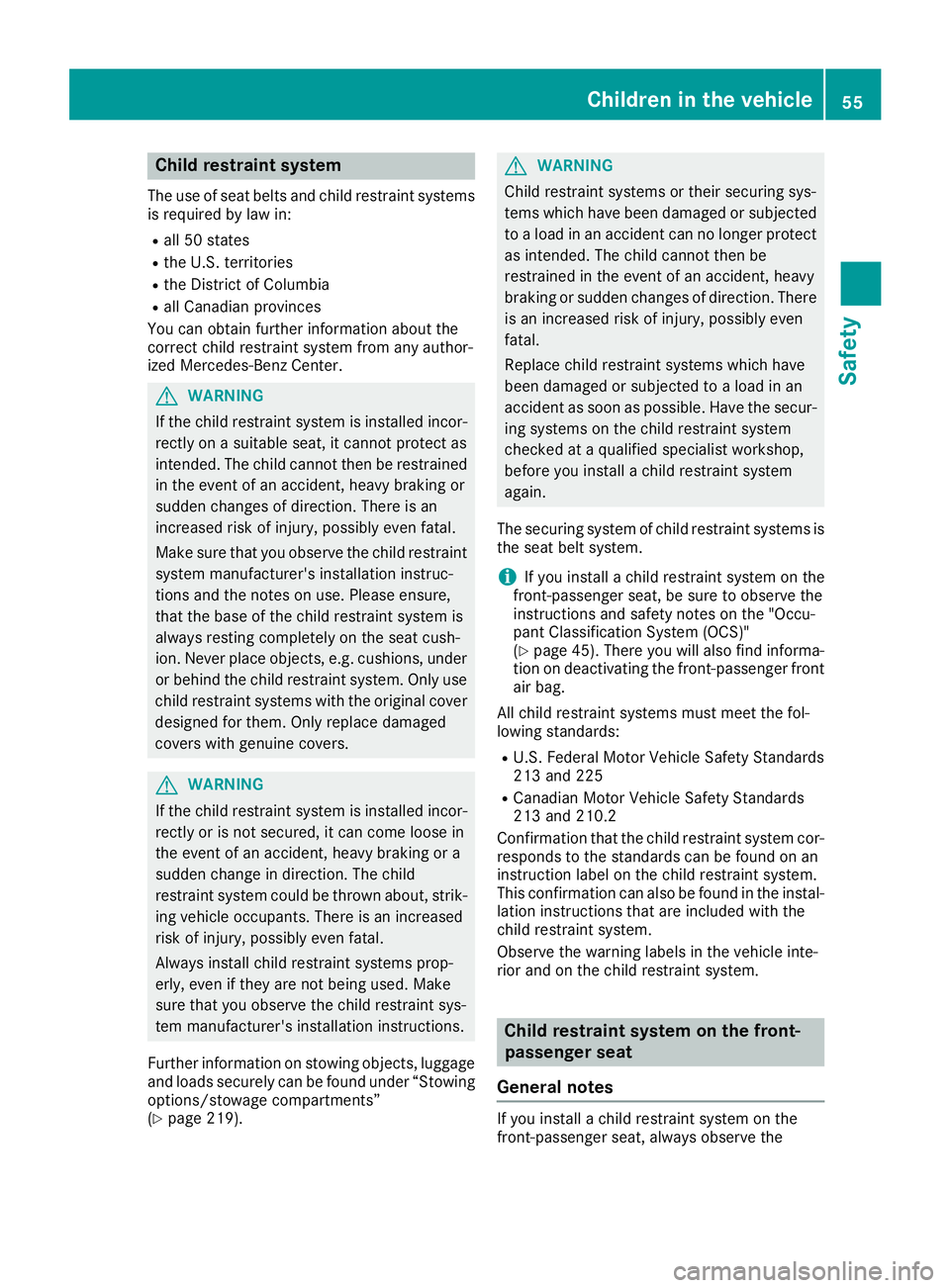
Child restraint system
The use of seat beltsand child restraint systems
is required by law in:
Rall 50 states
Rth eU .S.t erri tories
RtheD istrict of Columbia
Rall Canadian provinces
You can obtain further informatio nabout the
correc tchild restraint system from any author-
ize dM ercedes-Ben zCenter.
GWARNING
If th echild restraint system is installed incor-
rectly on asuitable seat,itc annotprotect as
intended. The child canno tthe nber estrained
in th eevent of an accident, heavyb raking or
suddenc hanges of direction.T hereisan
increased ris kofinjury, possibly eve nfatal.
Makes ure that you observ ethe child restraint
system manufacturer'si nstallationinstruc-
tions and th enotes on use. Pleasee nsure,
that th ebase of th echild restraint system is
always restin gcompletely on th eseat cush-
ion.N ever placeo bjects, e.g.cushions, under
or behindt hechild restraint system. Only use
child restraint systems witht heoriginal cover
designe dfor them. Only replace damaged
covers withg enuine covers.
GWARNING
If th echild restraint system is installed incor-
rectly or is no tsecured, it can com eloosei n
th ee vent of an accident, heavyb raking or a
suddenc hang eind irection.T he child
restraint system coul dbethrown about,s trik-
ing vehicle occupants .Thereisani ncreased
ris kofi njury, possibly eve nfatal.
Always install child restraint systems prop-
erly, eve niftheya re no tbeingu sed. Make
sure that you observ ethe child restraint sys-
te mm anufacturer'si nstallationinstructions.
Further informatio nonstowingo bjects, luggage
and loads securely can be foun dunde r“Stowi ng
options/stowage compartments”
(
Ypage 219).
GWARNING
Child restraint systems or their securin gsys-
tems whichh ave been damaged or subjected
to aload in an accidentc an no longer protect
as intended. The child canno tthe nb e
restraine dintheevent of an accident, heavy
braking or suddenc hanges of direction.T here
is an increased ris kofinjury, possibly even
fatal.
Replacec hild restraint systems whichh ave
been damaged or subjected to aload in an
accidentass oon as possible. Hav ethe secur-
ing systems on th echild restraint system
checked at aqualified specialist workshop,
before you install achild restraint system
again.
The securin gsystem of child restraint systems is
th es eat belt system.
iIf you install achild restraint system on the
front-passenger seat,bes ure to observethe
instructionsa nd safety note sonthe"Occu-
pantC lassificatio nSyste m(OCS)"
(
Ypage 45). Therey ou will also findinforma-
tio nond eactivatin gthe front-passenger front
air bag.
All child restraint systems must mee tthe fol-
lowings tandards:
RU.S. Federal Motor Vehicle SafetyS tandards
21 3a nd 225
RCanadian Motor Vehicle SafetyS tandards
21 3a nd 210.2
Confirmation that th echild restraint system cor-
responds to th estandards can be foun donan
instruction label on th echild restraint system.
This confir mation c
an also be foun
dintheinstal-
lation instructionst hata re included witht he
child restraint system.
Observ ethe warning labels in th evehicle inte-
rior and on th echild restraint system.
Child restraint system on th efront-
passengers eat
General notes
If you install achild restraint system on the
front-passenger seat,a lways observethe
Children in th evehicle55
Safety
Z
Page 58 of 298
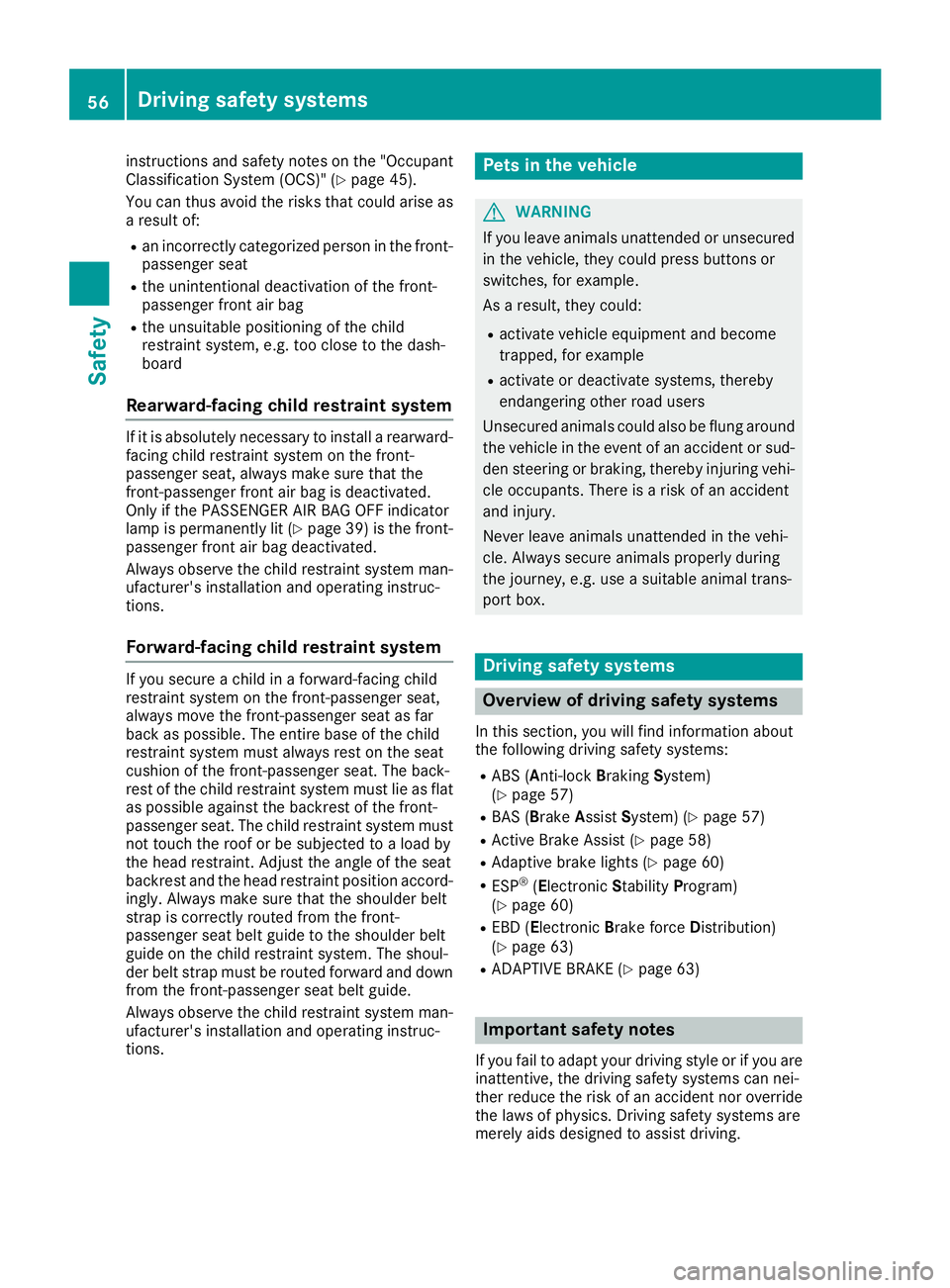
instructions and safetynotes on the "Occupant
Classification System (OCS)" (Ypage 45).
You can thus avoid the riskst hat could arise as
ar esult of:
Ran incorrectly categorized personint he front-
passenger seat
Rthe unintentional deactivatio nofthe front-
passenger front air bag
Rthe unsuitable positionin gofthe child
restraint system, e.g. too clos etothe dash-
board
Rearward-facing child restraint system
If it is absolutely necessary to install arearward-
facin gchild restraint system on the front-
passenger seat, always make sure that the
front-passenge rfront air bag is deactivated.
Only if the PASSENGER AI RBAG OFF indicator
lamp is permanently lit (
Ypage 39) is the front-
passenger front air bag deactivated.
Always observe the child restraint system man-
ufacturer'si nstallation and operating instruc-
tions.
Forward-facing child restraint system
If you secur eachild in aforward-facin gchild
restraint system on the front-passenge rseat,
always move the front-passenge rseat as far
back as possible.T he entire base of the child
restraint system must always rest on the seat
cushio nofthe front-passenge rseat. The back-
rest of the child restraint system must lie as flat
as possible against the backrest of the front-
passenger seat. The child restraint system must
not touc hthe roof or be subjected to aload by
the head restraint .Adjust the angle of the seat
backrest and the head restraint position accord- ingly. Always make sure that the shoulder belt
strap is correctly routed fromt he front-
passenger seat belt guide to the shoulder belt
guide on the child restraint system. The shoul-
der belt strap must be routed forward and down
fromt he front-passenge rseat belt guide.
Always observe the child restraint system man-
ufacturer'si nstallation and operating instruc-
tions.
Pets in th evehicle
GWARNING
If you leave animals unattended or unsecured
in the vehicle, the ycould press buttons or
switches, for example.
As aresult,t heyc ould:
Ractivatev ehicle equipmenta nd become
trapped, for example
Ractivateord eactivatesystems, thereby
endangeringo ther road users
Unsecure danimals could also be flung around
the vehicle in the eventofana ccident or sud-
den steeringorb raking, thereby injuring vehi-
cle occupants. There is arisk of an accident
and injury.
Never leave animals unattended in the vehi-
cle. Always secur eanimals properly during
the journey, e.g. use asuitable animal trans-
port box.
Driving safety systems
Overview of driving safety systems
In this section, you will findi nformation about
the followingd rivingsafetysystems:
RABS(Anti-lock Braking System)
(Ypage 57)
RBA S(Brake Assist System) (Ypage 57)
RActiveBrakeA ssist (Ypage 58)
RAdaptive brakel ights(Ypage 60)
RESP®(ElectronicStabilityProgram)
(Ypage 60)
REB D( Electronic Bra ke force Distribution)
(Ypage 63)
RADAPTIVE BRAKE (Ypage 63)
Important safety notes
If you fail to adapt your drivings tyle or if you are
inattentive, the drivings afetysystems can nei-
the rreducet he risk of an accident nor override
the laws of physics .Drivings afetys ystems are
merely aids designed to assist driving.
56Driving safety systems
Safety
Page 74 of 298

XTo deactivate:press and holdbutton :for
aboutf ives econds unti latone sounds.
XTo activate: press and hol dbutton ;for
aboutf ives econds unti latone sounds.
If yo upress one of the two buttons and do not
hea rat one, the relevant setting hasa lready
been selected.
The vehicl eislocked automaticall ywhent he
ignition is switched on and the wheels are turn-
ing.
Yo uc ould therefore lock yoursel fout if:
Rthe vehicl eisbeing pushed.
Rthe vehicl eisbeing towed.
Rthe vehicl eisonar ollerdynamometer.
Yo uc an also switch the automatic locking func-
tio nona nd off using the on-board computer
(
Ypage 173).
Unlocking/lockin gthe driver's door
using the mechanical key
i
If yo uwanttoc entrall yloc kthe vehicl eusing
the mechanical key,b eginby pressing the
locking button for the interio rloc king mech-
anism whil ethe driver's door is open. Then
lock the driver's door using the mechanical
key.
XTo unlock: turn the mechanical key counter-
clockwise as far as it will go to position 1.
XTo lock:turn the mechanical key clockwise as
far as it will go to position 1.
If yo uusethe mechanical key to unlock and
open the driver's door, the anti-thef talarm sys-
tem will be triggered .Switch off the alarm
(
Ypage 64).
Trunk
Important safety notes
GWARNING
If objects, luggage or load sare not secured or
not secured sufficiently ,they could slip ,tip
overorbef lung around and thereb yhitvehicle
occupants. There is ariskofi njury,p articu-
larly in the event of sudden braking or asud-
de nc hange in direction.
Alway sstoreo bjects so thatt hey cannotbe
flung around .Secure objects, luggage or
load sagain st slipping or tipping before the
journey.
!The trunk li dswing su pwar ds when opened.
Therefore, make sure thatt hereiss ufficient
clearance above the trunk lid.
!Onlyc lose the trunk once the roofisl owered
completely. Otherwise, yo ucould damag ethe
roof.
If yo uclose the trunk li dbefore the roofi s
lowered completely, the loading ai dswitch
lights up and awarning tone sounds.
The opening dimensions of the trunk li dcan be
found in the "Vehicle data" section
(
Ypage 295).
Do not leave the SmartKey in the trunk. You
could otherwise lock yoursel fout.
The trunk li dcan be:
Ropened/closedf rom outside
Ropenedautomaticall yfrom outside
Rlocked separately
Ropene dwitht he emergency release button
Runlockedw itht he mechanical key
Yo us houl dpreferabl yplace luggage or load sin
the trunk.
72Trunk
Opening and closing
Page 83 of 298
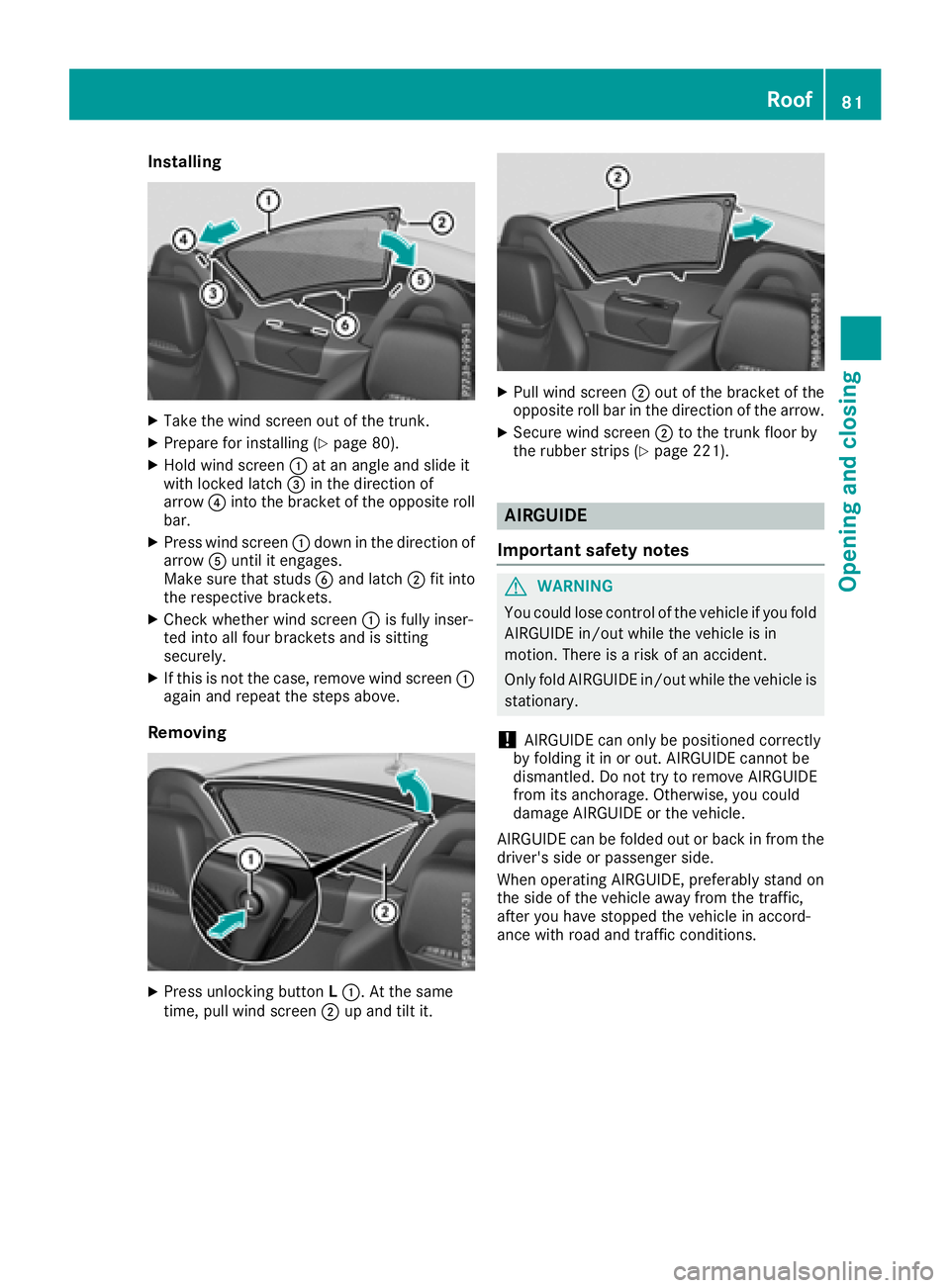
Installing
XTakethewin dscree no ut of th etrunk.
XPrepare for instal ling(Ypage 80).
XHol dw inds creen :at an ang leand slide it
wit hlocke dlatch =inthed irection of
arrow ?intot he bracke toftheoppo siteroll
bar.
XPress windscreen :down in thed irection of
arrow Auntil it engages.
Makes ure that studs Band latch ;fit into
th er espectiv ebrackets.
XCheckw hetherwindscreen :isfully inser-
te di ntoa llfour brackets and issitting
securely.
XIf th is is notthe case, remove windscreen :
again and repeat th esteps above.
Removing
XPress unlocking button L:.Att hesame
time, pull win dscreen ;up and til tit.
XPull winds creen ;out of th ebracke tofthe
oppo siteroll bar in th edirection of th earrow.
XSecure windscreen ;to th etrunk floor by
th er ubber strips (Ypage 221).
AIRGUIDE
Important safety notes
GWARNING
You could lose control of th evehicle ifyou fold
AIRGUID Ein/out while th evehicle isin
motion.T hereisar iskofana ccident.
Only foldA IRGUIDEi n/out while th evehicle is
stationary.
!AIRGUID Ecan only be positione dcorrectly
by foldingitinoro ut.AIRGUIDEc annotbe
dismantled. Do no ttry to remove AIRGUIDE
from its anchorage. Otherwise, you could
damag eAIRGUIDEort hevehicle.
AIRGUID Ecan be folded out or back in from the
driver' sside or passenger side.
When operating AIRGUIDE, preferably stand on
th es ide of th evehicle away from th etraffic,
after you have stoppe dthe vehicle inaccord-
anc ewithr oad and traffic conditions.
Roof81
Opening and closing
Z
Page 87 of 298

The seats can still be adjusted when there is no
SmartKey in the ignition lock.
GWARNING
When you adjust aseat, you or other vehicle
occupantsc ould become trapped, e.g. on the
seat guide rail. There is arisk of injury.
Make sure when adjusting aseat that no one
has any body parts in the sweep of the seat.
GWARNING
If the driver's seat is not engaged, it could
move forwards as far as the next catc hduring
movements uch as braking or abrupt changes
of direction .Asaresult, you would be pushed
against your seat belt by the unsecured driv-
er's seat.
This could cause you to lose control of the
vehicle. The seat belt cannot protec tasinten-
ded and could result in additional injury.
There is arisk of an accident and injury.
Before every journey, make sure that the driv-
er's seat is fully engaged.
Observe the safety notes on "Air bags"
(
Ypage 43) and "Children in the vehicle"
(Ypage 53).
GWARNING
If the driver's seat is not engaged, it could
move unexpectedly while the vehicle is in
motion.T his could cause you to lose control of
the vehicle. There is arisk of an accident.
Always make sure that the driver's seat is
engaged before starting the vehicle.
GWARNING
If you adjust the seat height carelessly, you or
other vehicle occupantsc ould be trapped and
thereby injured. Children in particular could
accidentally press the electrical seat adjust-
ment button sand become trapped. There is a
risk of injury.
While moving the seats, make sure that your
hands or other body parts do not get under the
lever assembly of the seat adjustmen tsys-
tem.
GWARNING
If the head restraints are not installed or not
adjusted correctly, they cannot provide pro-
tection as intended. There is an increased risk
of injury in the head and neck area, e.g. in the event of an accident or when braking.
Always drive with the head restraints instal-
led. Before driving off, make sure for every
vehicle occupant that the center of the head
restraint supports the back of the head at
about eye level.
GWARNING
You could lose control of your vehicle if you do the following while driving:
Radjust the driver's seat, head restraint,
steerin gwheel or mirrors
Rfasten the seat belt
There is arisk of an accident.
Adjust the driver's seat, head restraint, steer-
ing wheel and mirror and fasten your seat belt before starting the engine.
!To prevent damage to the seats and the seat
heating, observe the following notes:
RDo not spill liquids ontot he seats. Dry the
seats as soon as possible if liquid does get
spilled on the seats.
RIf the seat covers are damp or wet, do not
switch on the seat heating. Also, do not use
the seat heating to dry the seats.
RClean the seat covers as recommended;
see the "Interior care" section.
RDo not transport heavy loads on the seats.
Do not place pointed object sonthe seat
cushions such as knives, nails or tools.
Where possible, use the seats only for car-
rying passengers.
RWhen operating the seat heating, do not
cover the seats with insulating materials,
e.g. blankets ,coats, bags, protective cov-
ers, child seats or booster seats.
RWhen the seat heating is switched on, the
seat surface can be damaged as aresult of
object sbeing placed on the seats; for
example, seat cushions, child seats and
protective covers not approved by
Mercedes-Benz.
Seats85
Seats, steering wheel and mirrors
Z